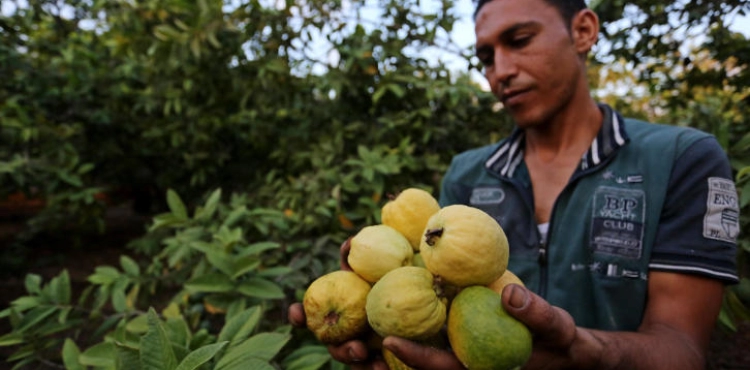Guava farmers in the Gaza Strip began harvesting the fruits of their trees a few days ago, but this year the season lost more than half of production compared to last year due to the spread of agricultural pests and the increasing salinity of irrigation water.
Nematodes and a fungus called fusarium have destroyed dozens of guava trees and their fruits.
"Nematodes" are tiny worms, also known as "snake worms", which complicate the roots and infect them with severe ulcers, affect their nutrients and lead to general weakness and may eliminate trees infected.
Farmers say they have lost 60 percent of their production this year of guava compared to last season, threatening to continue growing autumn fruit in the coming years.
In one of the largest guava farms in Al-Mawasi area, west of Khan Younis, in the south of the Gaza Strip, the farmer Mahmoud Zo´rob, 65, is trying to save what can be saved from guava trees at his farm, after being invaded by the pest of "Nematoda" by using special drugs to combat them.
"Large numbers of trees have been hit by the pest of the nematode, destroyed or destroyed," Zourob said.
"In addition to the pest of the nematode, fusarium has infected farms adjacent to its farm, causing large numbers of guava trees to be damaged."
Zu´rob explains that the salinity of irrigation water is increasing rapidly every year due to the high consumption of groundwater, and the leakage of seawater and wastewater to groundwater wells.
The Gaza Strip produces about 3,000 tons of guava per year, and the price per kilogram according to its quality ranges between 2-4 shekels (the dollar equals 3.5 shekels).
According to the data of the Ministry of Agriculture in Gaza, the average production per acre (1000 square meters) about 1.7 tons of guava per year, while the average annual consumption per capita in the Gaza Strip autumn fruit at 5-6 kilograms.
The guava harvest begins at the beginning of September each year and lasts until mid-November. Hundreds of workers participate in the harvesting of guava, which is a good source of livelihood for them.
Adham al-Bassiouni, a spokesman for the Ministry of Agriculture in the Gaza Strip, said that "the area of ​​land planted with guava trees throughout the Gaza Strip, amounting to about 2500 acres during the current season."
The area of ​​guavas cultivated in Gaza was 6,000 dunums in 2005, according to previous official data.
The area of ​​agricultural land in the Gaza Strip is about 173 thousand dunums, of which 82 thousand dunums planted with vegetables, and 71 thousand and 400 dunums planted with fruits, according to previous data of the Ministry of Agriculture.












